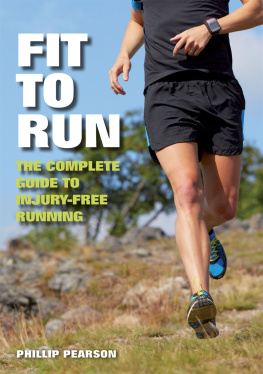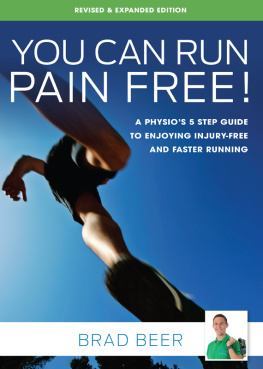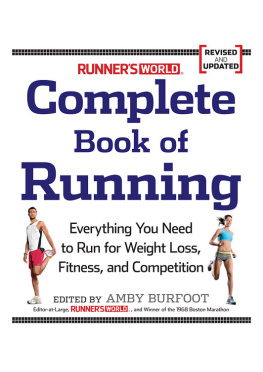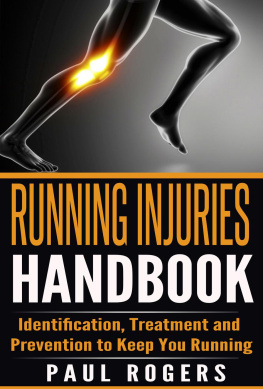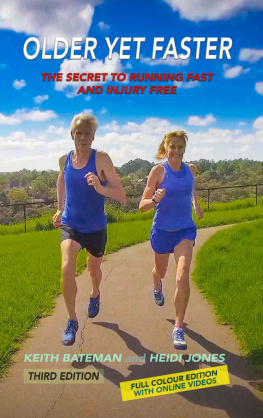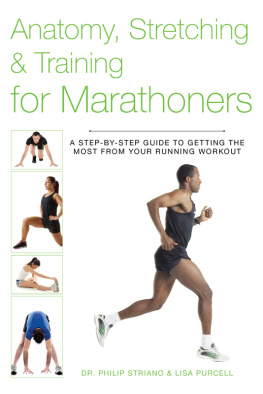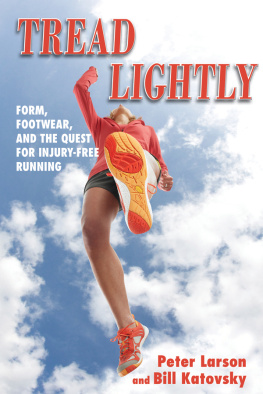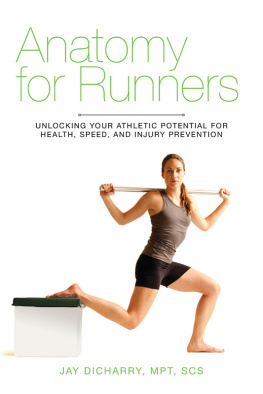FIT TO RUN
THE COMPLETE GUIDE TO
INJURY-FREE RUNNING
PHILLIP PEARSON

THE CROWOOD PRESS
First published in 2014 by
The Crowood Press Ltd
Ramsbury, Marlborough
Wiltshire SN8 2HR
www.crowood.com
This e-book first published in 2014
Phillip Pearson 2014
All rights reserved. No part of this publication may be reproduced or transmitted in any form or by any means, electronic or mechanical, including photocopy, recording, or any information storage and retrieval system, without permission in writing from the publishers.
British Library Cataloguing-in-Publication Data
A catalogue record for this book is available from the British Library.
ISBN 978 1 84797 702 1
Frontispiece: Graham Hillditch
CONTENTS
INTRODUCTION
This book is for runners of all standards, whether complete beginners aiming to increase health-related fitness and weight control, or experienced club runners competing in distance races of fve, ten, twenty kilometres, or a full marathon.
Any exercise programme should be based on scientific principles and participants should have some knowledge of the body, how it works, how it responds to training and what can go wrong.
Running is a very accessible and inexpensive form of aerobic conditioning. All that is needed is a suitable pair of running shoes, appropriate clothing and the courage to step out of the front door.
The human body is designed to run. Our earliest ancestors ran great distances in order to survive, hunting to eat, often out-running their quarry until it became exhausted. They would even have had to run to avoid becoming prey. Had they not been designed to run, and able to run, they would not have survived. Mankind would have died out and we would not be here today.
Over many millennia, and because of ever-increasing labour-saving technology, man has eliminated the need to run and body structures have weakened, especially the feet (see more about the structure and function of the human foot in ).
Running injuries occur because of the bodys reliance on artificial devices, which try to compensate for weaknesses in tissues subjected to too much stress too soon.
Our bodies are basically the same as early man and we are still designed to run, despite what the sceptics might say. Those who preach the dangers of running usually do so out of personal belief, not backed up by scientific evidence, research or study. The benefits of running far outweigh the hazards.
Running provides many health-related benefits, such as:
Cardio-protection Running, as a form of aerobic conditioning exercise, strengthens the heart muscle (myocardium); it helps to lower and control blood pressure and increases levels of good cholesterol (HDL). |
Muscle tone Running strengthens and tones skeletal muscle, making everyday tasks easier and potentially improving posture. |
Bone strength Running is weight-bearing exercise that increases bone density and bone strength. |
Weight control Running increases calorie expenditure and can assist with weight reduction and weight control, which in turn can contribute towards cardio-protection. |
Relief from stress Running increases the secretion of mood-enhancing hormones known as endorphins, chemicals which affect the brain to bring about a more relaxed state of mind. |
Social wellbeing Although sometimes it can be pleasant to run by yourself, alone with your thoughts, it may be more interesting to run with another person, not only for social interaction (for maximum aerobic benefit you should be running at a pace whereby you can maintain a conversation), but also as a safety precaution, especially for women who might feel vulnerable alone on dark nights, in open countryside or parkland. |
The term prevention of running injuries may be a misnomer: it is not possible to prevent injury. Injuries can happen despite the best precautions. What we can do, however, is reduce the risk of injury. This requires a degree of knowledge an awareness of correct warm-up and essential cool-down, the importance of stretching for muscle suppleness and joint flexibility, the development and maintenance of core strength and stability, the development of a recommended running technique, an awareness of current fitness level, appropriate intensity and progression, and a knowledge of how the body adapts to exercise and training.
The information, suggestions and recommendations offered in this book are advisory and are based on scientific knowledge, research and many years experience. It should therefore be understood that the author and publishers carry no liability.
Running for Fitness and Fit to Run
What do we mean by fitness? Many authorities have attempted to define the meaning of fitness. Sharkey (1990) spoke of both aerobic and muscular fitness. He defined aerobic fitness as the capacity to take in, transport and utilize oxygen, developed and maintained through large-muscle activities such as walking, jogging, cycling, swimming, and other activities that allow sustained metabolism. For muscular fitness he included strength, muscle endurance and flexibility.
Cullum and Mowbray (1989) spoke of total fitness, which includes physical, nutritional, medical, mental, emotional and social fitness. They defined total fitness as the ability to meet the demands of the environment, plus a little in reserve for emergencies. They defined physical fitness as the capability of the heart, blood vessels, lungs and muscles to function at optimal efficiency.
Hazeldine (1992) wrote that fitness refers to the total dynamic physiological state of the individual, ranging on a continuum from optimal human performance to severe debilitation and death.
Honneybourne et al. (1996) described fitness simply as the ability to cope effectively with the stresses of everyday life.
Glover et al. (1996) stated that physical fitness implies optimal functioning of all physiological systems of the body, particularly the cardiovascular, pulmonary and musculo-skeletal systems.
Fit for What?
It is generally considered that there are two types of fitness: general fitness (or health-related fitness) and specific fitness (sometimes referred to as sport-related, skill-related, or task-related fitness).
General or health-related fitness

